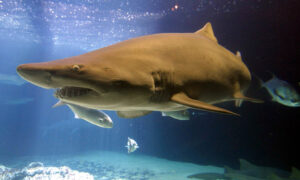Where Do Fish Go for Scratch Relief? Their Predators
Marine biologists have discovered that when fish are faced with the dilemma of developing an itch offshore in the open ocean, yet with no hands, plants, or animals to help them scratch it, they have a curious solution of seeking out their predators—sharks.Viewing thousands of hours of video footage, Australian marine ecologist Chris Thompson and marine biologist Jessica Meeuwig found that fish can usually scratch their itch against rocks, corals and animals like turtles, but in their absence, they found the large surfaces of sharks to be the most suitable texture for relieving their itch. “Shark skin is made up of small tooth-like structures called dermal denticles. It feels like sandpaper (and in pre-industrial times, it was used for that purpose), making it a particularly suitable surface against which to scratch,” co-author of the study Thompson said. Despite the risky behaviour, the researchers have yet to witness a fish fatality, although smaller fish are less likely to scrape on bigger sharks, “perhaps due to the risk of being eaten.” He noted that the footage of the behaviour was taken using chum, so the sharks may have been focused on the bait in the water. Hosts to Parasites, Dead Skin, Irritants The researchers found that fish tended to scratch their heads, eyes, nostrils, and sides more than other parts of their body, as this is where many of the areas were most heavily impacted by parasites. “Parasites can negatively affect the fitness of their hosts by draining resources and diverting energy from growth, reproduction and other bodily functions,” Thompson said. Their new research, published in PLOS One, examined and recorded the scraping behaviour of tuna, blue sharks, and mako sharks in the three ocean basins—the Pacific, Indian, and Atlantic. They observed that different species had differing scratching methods. For instance, yellowfin tuna approach sharks from behind and rub against their tails, while rainbow runners bump against the shark’s body. Thompson said the continued decline of shark populations could have an effect on other fish populations like the ones they observed. “The reduction in many species may limit these interactions, eroding possible fitness benefits associated with this behaviour and consequently placing more pressure on already highly targeted and vulnerable species,” he said. Follow Jessie Zhang is a reporter based in Sydney covering Australian news, focusing on health and environment. Contact her at [email protected].

Marine biologists have discovered that when fish are faced with the dilemma of developing an itch offshore in the open ocean, yet with no hands, plants, or animals to help them scratch it, they have a curious solution of seeking out their predators—sharks.
Viewing thousands of hours of video footage, Australian marine ecologist Chris Thompson and marine biologist Jessica Meeuwig found that fish can usually scratch their itch against rocks, corals and animals like turtles, but in their absence, they found the large surfaces of sharks to be the most suitable texture for relieving their itch.
“Shark skin is made up of small tooth-like structures called dermal denticles. It feels like sandpaper (and in pre-industrial times, it was used for that purpose), making it a particularly suitable surface against which to scratch,” co-author of the study Thompson said.
Despite the risky behaviour, the researchers have yet to witness a fish fatality, although smaller fish are less likely to scrape on bigger sharks, “perhaps due to the risk of being eaten.”
He noted that the footage of the behaviour was taken using chum, so the sharks may have been focused on the bait in the water.
Hosts to Parasites, Dead Skin, Irritants
The researchers found that fish tended to scratch their heads, eyes, nostrils, and sides more than other parts of their body, as this is where many of the areas were most heavily impacted by parasites.
“Parasites can negatively affect the fitness of their hosts by draining resources and diverting energy from growth, reproduction and other bodily functions,” Thompson said.
Their new research, published in PLOS One, examined and recorded the scraping behaviour of tuna, blue sharks, and mako sharks in the three ocean basins—the Pacific, Indian, and Atlantic.
They observed that different species had differing scratching methods. For instance, yellowfin tuna approach sharks from behind and rub against their tails, while rainbow runners bump against the shark’s body.
Thompson said the continued decline of shark populations could have an effect on other fish populations like the ones they observed.
“The reduction in many species may limit these interactions, eroding possible fitness benefits associated with this behaviour and consequently placing more pressure on already highly targeted and vulnerable species,” he said.












